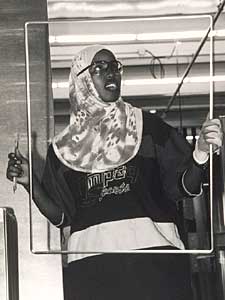|
Audio
Photos
Resources
|
February 17, 2005
A new photo exhibit at the Plains Art Museum in Fargo examines the lives of recent immigrants. The collection of black and white photos captures some of the images of refugees from many lands who live in Fargo.
Fargo, N.D. — When Meg Luther Lindholm moved to Fargo from New York City in 2002, she decided to look for a photo documentary project on immigration.
She found an ideal place to start her project at a Fargo glass factory that employees immigrants from more than 18 countries.
"It's quite an amazing operation," says Lindholm. "It's a huge factory, and there are people who speak English and some who don't. Speaking English doesn't seem to be a requirement for getting a job there. Everyone seems to get along pretty well."
One of the people Lindholm met at Cardinal Glass was Mustafa, a refugee from Somalia. Mustafa is a devout Muslim.
"He prays five times a day, including once when he's at work, on his break," says Lindholm. "At noon he goes to the bathroom and washes his hands and face, comes back out and puts a piece of cardboard on the floor behind the assembly line. He's really hidden from view, and he does his prayers to Allah, facing east."
As Meg Lindholm began photographing immigrants, she quickly realized she also wanted to know their stories. So she interviewed the people she photographed and paired the photos with text that offers a small insight into the lives of those captured in the black and white images.
Haditha Suliman was forced to flee her Sudanese homeland more than 15 years ago.
"She and her husband fled when her son was two years old. She didn't feel it would be safe to cross the whole country on foot with her young son, so she left her son in the care of her mother, his grandmother. And for 15 years she knew nothing of his whereabouts. She didn't know if he was dead or alive," recalls Lindholm.
"Her Christian religion really helped her draw strength, and in a sense, through her religion she was able to say, 'Well, he's in God's care. I can't do anything, but hopefully God will take care of him.' I guess God did because 15 years later they were reunited."
The photo shows Suliman in prayer as her son plays a guitar and sings.
"I think the photograph really conveys a sense of her devotion and how much prayer means to her and how much prayer gives her strength," says Lindholm.
Like many refugees Meg Lindholm met, Haditha Suliman often works two full-time jobs so she can send money home to help her family.
"And when she gets too exhausted working two full-time jobs and taking care of a family, she quits one for awhile, gets her strength back, and then goes back to two full-time jobs. It's just extraordinary," says Lindholm. "I don't know how she does it."
Many of the refugees documented in "Windows on the World: Refugees and Immigrants in Fargo-Moorhead," didn't intend to come to America, according to Lindholm.
"All they knew was the situation in their homeland was so awful they wanted to go almost anywhere else to start over."
Fargo-Moorhead was not what many immigrants expected America to be. The skyscrapers and crowded streets of New York City was their image of America.
"It was a shock for a lot of people when they arrived. One man from Sudan told me he didn't know what snow was. The first time it snowed he thought it was cotton falling from the sky," says Lindholm.
"The pace is something a lot of people talked about. People here are so busy and everyone has so much going on," says Lindholm. "That was one of the common themes I heard. It's lonely here."
The sense of loneliness is depicted by a photo of Muamer, a Bosnian man.
"He's someone who's really struggled with that sense of loneliness," says Lindholm.
"He says, 'When I wake up in the morning here there's nothing to do. It's different from Sarajevo, where there's going to be someone to drink coffee with. But here, when you wake up, you know you're just going to work,'" says Lindholm, reading from the text mounted beside the photo.
Lindholm says she's been struck by the suffering of the people she photographed, and by their resilience as they build new lives in a new place.
"Windows to the World: Refugees and Immigrants in Fargo-Moorhead," is on display at the Plains Art Museum in Fargo until April 17, 2005.








